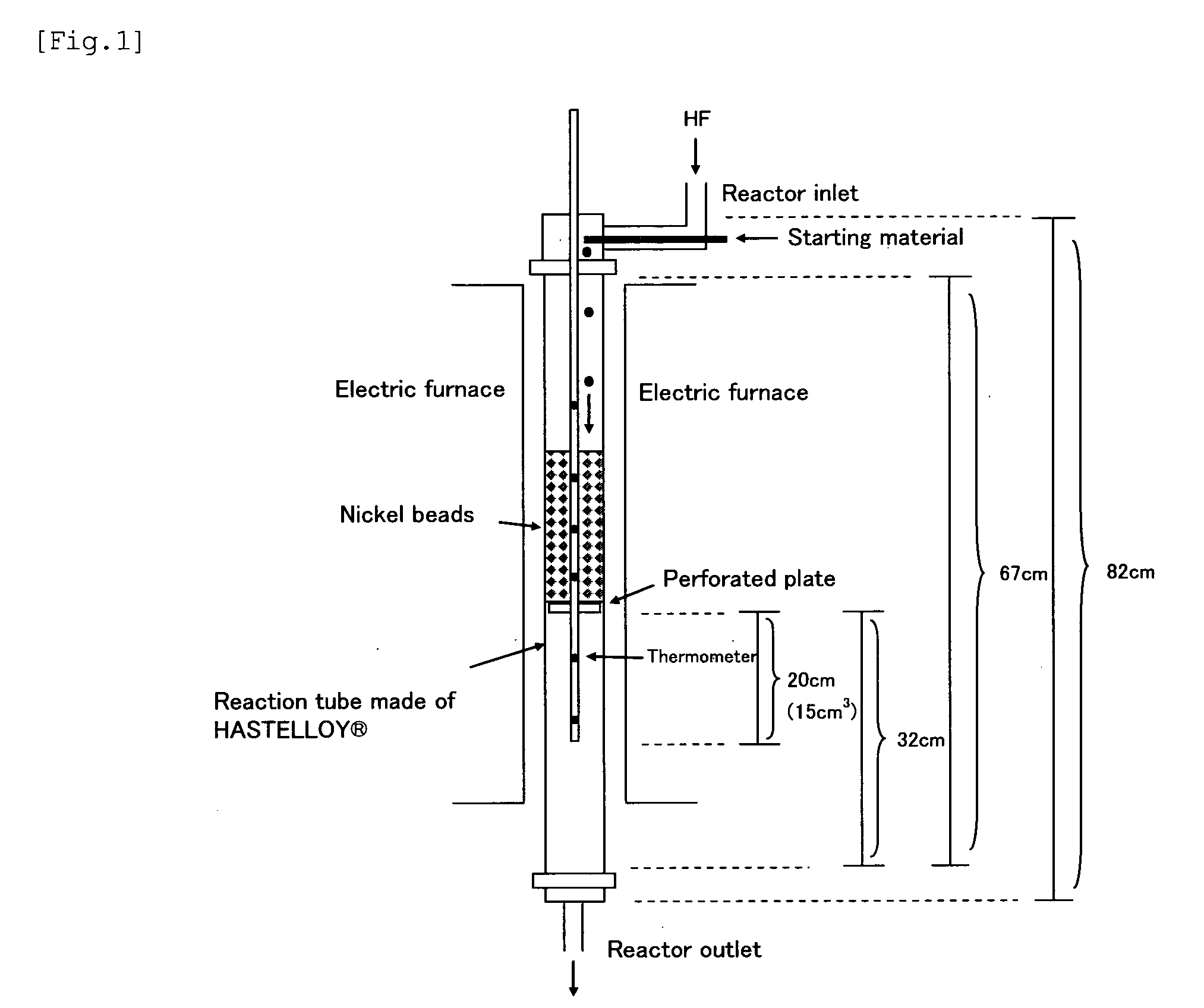Process for preparing chlorine-containing fluorocarbon compound
a fluorocarbon compound and chlorine technology, applied in the field of process for preparing fluorineand chlorinecontaining propane and propene compounds, can solve the problems of low selectivity, difficult handling of chlorine, waste treatment upon disposal, etc., and achieve the effect of short reaction time and high yield
- Summary
- Abstract
- Description
- Claims
- Application Information
AI Technical Summary
Benefits of technology
Problems solved by technology
Method used
Image
Examples
production example 1
[0052]1,1,1,2,3-Pentachloropropane (HCC-240db) was produced by sequentially conducting Steps (1) to (3) described below.
(1) Process for Preparing 1,1,1,3-Tetrachloropropane (HCC-250fb)
[0053]A 1,000 ml autoclave equipped with a thermometer, a vacuum line, a nitrogen purge line, a feeding line, a gauge, and a pressure relief valve was charged with 9.72 g (171 mmol) of soft iron powder, 48 g (260 mmol) of triethyl phosphate, 200 mg of ferric chloride, and 810 g (5.26 mol) of carbon tetrachloride, and was purged 5 times with nitrogen, and once with ethylene. The autoclave was then evacuated and charged, under stirring, with ethylene to a gauge pressure of 0.4 MPa. When the autoclave was heated to an internal temperature of 110° C., the reaction was initiated, and the internal temperature was increased to 134° C., while the pressure was decreased from 0.8 MPa to 0.25 MPa. While the pressure of ethylene was maintained at 0.8 MPa, stirring was continued at an internal temperature of 120° C...
production example 2
[0058]The following process was performed to prepare a mixture of 1,1,2,3-tetrachloropropene (HCC-1230xa) and 2,3,3,3-tetrachloropropene (HCC-1230xf).
Process for Preparing 1,1,2,3-Tetrachloropropene (HCC-1230xa) and 2,3,3,3-Tetrachloropropene (HCC-1230xf)
[0059]A 1,000 ml four-necked flask equipped with a thermometer and a condenser tube was charged with 330 g (1.52 mol) of 1,1,1,2,3-pentachloropropane (HCC-240db) obtained in Step (3) of Production Example 1, 310 g of 40% aqueous KOH solution, and 6 g of phase-transfer catalyst (Aliquat 336).
[0060]The reaction was allowed to proceed under stirring at 80° C. in an oil bath for 3 hours. After completion of the reaction, the resulting product was cooled and distilled under reduced pressure (1 mmHg), and a fraction at 20° C. to 22° C. was collected to obtain 259 g (1.44 mol, yield 94.8%) of a mixture of HCC-1230xa and HCC-1230xf (HCC-1230xa:HCC-1230xf=38:62 (1.44 mol, yield: 94.8%)) at a purity of 99.9%.
example 1
[0061]A tubular reactor made of HASTELLOY®, having an inner diameter of 10 mm and a length of 82 cm was packed with 33.0 g of nickel beads (cylinder shaped, diameter: 2 mm; height: 2 mm) that were inactive against the reaction. The length of the packed nickel beads was 8.2 cm, and the void volume of this packed bed of the nickel beads was 2.3 cm3. An insertion tube was introduced inside the reaction tube from the top to measure the temperature inside the reaction tube including the nickel bead-packed bed. FIG. 1 schematically illustrates the reactor used. The reaction tube was maintained at atmospheric pressure (0.1 MPa) and a temperature of 290° C., and anhydrous hydrogen fluoride (HF) was continuously introduced into the reactor at 60 cc / min (flow rate at 0° C. and 0.1 MPa) for 0.5 hours.
[0062]Thereafter, 1,1,1,2,3-pentachloropropane (HCC-240db, purity: 99.6%) was continuously supplied at a rate of 6.0 cc / min (flow rate at 0° C. and 0.1 MPa) while 1,1,1,2,3-pentachloropropane was ...
PUM
| Property | Measurement | Unit |
|---|---|---|
| reaction temperature | aaaaa | aaaaa |
| temperature | aaaaa | aaaaa |
| temperature | aaaaa | aaaaa |
Abstract
Description
Claims
Application Information
 Login to View More
Login to View More - Generate Ideas
- Intellectual Property
- Life Sciences
- Materials
- Tech Scout
- Unparalleled Data Quality
- Higher Quality Content
- 60% Fewer Hallucinations
Browse by: Latest US Patents, China's latest patents, Technical Efficacy Thesaurus, Application Domain, Technology Topic, Popular Technical Reports.
© 2025 PatSnap. All rights reserved.Legal|Privacy policy|Modern Slavery Act Transparency Statement|Sitemap|About US| Contact US: help@patsnap.com

